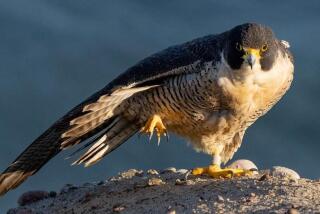Ecologists’ hopes soar on the wings of a gnatcatcher
The researchers waded through the Palos Verdes Peninsula’s tilted thickets of sage last summer hoping to find at least 56 pairs of California gnatcatchers, the same number counted a dozen years ago.
But to their surprise -- and delight -- the final count hit 72 pairs, about 29% more than were discovered in 1994.
“We were incredibly excited at the numbers,” said Andrea Vona, a habitat restoration expert with the Palos Verdes Peninsula Land Conservancy. “After all, this bird needs our coastal landscapes to thrive.”
Most of the small, secretive songbirds were spotted in protected conservancy lands, including the year-old Portuguese Bend Nature Preserve, according to survey results made public in mid-November.
But populations had also settled into hundreds of acres of restored coastal sage scrub surrounding the area’s seaside bedroom communities overlooking the breakers of the Pacific.
Though the federally threatened bird hasn’t completely rebounded yet, its ongoing recovery in the peninsula is encouraging to scientists, and Vona described the comeback during a hike last week along a sunny, wind-swept hillside. A series of faint kitten-like mews gave away the location of two California gnatcatchers prowling for insects in a patch of nursery-grown sage just a few yards from the entrance of the Trump National Golf Club.
Just 4 1/2 inches long, the once-common species is a year-round resident of peninsula habitats with coastal sage scrub -- a plant community dominated by sagebrush, buckwheat, coyote bush, lemonade berry and beaver-tail cactus -- that are crawling with the gnats, spiders, bees and ants that gnatcatchers prefer.
Peering through binoculars at the blue-gray birds with black tails foraging in the undergrowth on the far side of a gully, Vona smiled and said, “They’re living symbols of the uniqueness of this place and the importance of preservation and restoration of habitat -- and very cute.”
Federal biologists and city officials hailed the discovery of so many of the birds in the peninsula as a sign that a decade of habitat restoration efforts is favoring the species, which had diminished almost to the vanishing point.
“We’re happy and proud of the results,” said Joel Rojas, Ranchos Palos Verdes’ director of planning, building and code enforcement. “Ten years ago, the city was in danger of losing its gnatcatchers.”
Now, he added, “I see them all the time fluttering in the bushes right outside my office window.”
In 1994, a survey accounted for at least 56 pairs of the gnatcatchers in the peninsula, about 20 miles south-southwest of downtown Los Angeles.
The 72 pairs found this summer included 19 pairs that had settled into 125 acres of restored habitat in and around the Trump National Golf Club.
Angel Murillo, who maintains the golf course’s habitat and trails, makes it his business to keep track of the birds and their nests. He also sets traps to rid the area of predators, including foxes and cats. “We’re trying to keep the habitat safe for their little babies,” Murillo said. “And it’s working, because every year we’re seeing more and more gnatcatchers.”
For decades, the California gnatcatcher was regarded as the poster child for threatened natural habitat in one of the fastest-growing regions in the nation.
Throughout Southern California, particularly in Orange and San Diego counties, “gnatcatcher wars” stalled building projects for several years until agreements in the mid-1990s created preserves of tens of thousands of acres to protect the sage habitat where the birds nest almost exclusively.
By that time, however, the birds had been pushed out of two-thirds of their ancestral haunts by urban development and fires. Today, there are an estimated 2,900 California gnatcatchers left in the United States. In Los Angeles County, most of the birds reside on the Palos Verdes Peninsula.
“Before construction began on the golf course, we counted three pairs in what was then a weedy plateau,” said Michael Sweesy, senior habitat restoration specialist for Dudek, the consulting firm that developed the golf course’s restoration program. Today’s population marks “a 600% increase over a 10-year period.”
Similar increases have been recorded in restored portions of the newly created 80-acre White Point Nature Preserve, about a mile south of the golf course.
Many of the gnatcatchers counted last summer belonged to existing populations in the nearby Portuguese Bend Nature Preserve, a relatively intact 1,100-acre haven for the birds.
The bird -- found only in Southern California and northern Baja -- is on the federal list of threatened species and is a “species of concern” in the state.
Scientists say the northernmost known habitat for the species is in the Whittier and Montebello hills.
“Gnatcatcher recovery seems to be happening at an inflated rate on the Palos Verdes Peninsula,” said Ken Corey, U.S. Fish and Wildlife Service division chief for Los Angeles and Orange counties. “In fact, it’s the highest success rate we’ve seen anywhere.”
But Jonathan Atwood, one of the nation’s leading experts on gnatcatchers, expressed cautious optimism, given that the birds are prone to dramatic population rises and crashes.
“It may be too soon to sound the trumpets of victory,” he said.
Kimball L. Garrett, chief ornithologist of the Natural History Museum of Los Angeles County, agreed.
“When habitat is preserved and restored, it’s always nice to have it validated by the proper results,” he said. “But my concern is this: Are we really showing a positive trend that will hold, or did we just happen to count them at a good time in their population cycle?”
Vona, however, suggested the encouraging population figures support a fundamental principle of ecology: “Protect and build habitat,” she said, “and nature will occupy it.”
*
More to Read
Sign up for The Wild
We’ll help you find the best places to hike, bike and run, as well as the perfect silent spots for meditation and yoga.
You may occasionally receive promotional content from the Los Angeles Times.







